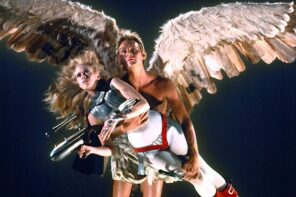On July 14, 1518, Frau Troffea began to dance in Strasbourg’s central marketplace. This otherwise unremarkable Alsatian woman began to kick up her legs and flail her arms rhythmically to some unheard music. She did so for six days, stopping only briefly to sleep before resuming her frenzied dancing. By the end of the week she would be joined by three dozen dancers. By the end of the month the crowd had swelled to 400 women and men.
The strenuousness of non-stop dancing meant that dancers were continually expiring—from exhaustion, from injury, from heart attacks. An average of fifteen a day died from the rapidly spreading “plague.” But this was not an isolated incident: Dancing plagues had reoccurred throughout Europe from the twelfth-century through the decades after the outbreak of 1518, whether because of hysteria, delusion, mass psychosis, trance, or something else. That cracked festival, whose 500th anniversary we mark this summer, was the second largest such incident on record, and the largest after the invention of the printing press. Guttenberg’s device spread the news of said marathon throughout Alsace, the Rhineland, and the Low Countries, in turn inspiring new flares of this psychic contagion.
The past is sometimes configured as an alien land; easy to approach the strange doings, ideas, and people of centuries long gone as a demonstration of the undeniable strangeness of our ancestors, the better by which to favorably compare ourselves. We shouldn’t be so content. In his indispensable account The Dancing Plague, medical historian John Waller emphasizes that the phenomenon conveys “an important truth: that the dancing manias could not have happened had it not been for the potential strangeness inherent in all of us.”
There’s a cracked value in that. After all, the dancers of Strasbourg were subjects of a rapidly changing world where suddenly old verities were in question, the mania spreading by means of the “new media” of the printing press, along with all manner of unconfirmed, superstitious ideas. Are you really so certain that Twitter, Facebook, or any of our modern equivalents of the printing press couldn’t be similarly disruptive to the psychic well-being of your fellow citizens? At a time when a disturbingly large number of people believe in the “QAnon” conspiracy; when “pizzagate” inspired a gunman to raid a pizzeria; where “flat-Earthers” have a growing fan-base; or where people ingest Tide Pods; can we really argue that these aren’t as foolish a bit of mass hysteria as dancing oneself to death?
Scottish journalist Charles Mackay contends in his 1841 classic, Extraordinary Popular Delusions and the Madness of Crowds, that during times of social disarray we “find that whole communities … become simultaneously impressed with one delusion, and run after it”—or dance after it. Europe on the verge of modernity was a culture very much in a particular sort of disarray; old certainties were being questioned, political systems were rapidly changing, in some instances a dangerous new sense of nationalism was emerging in individual states, the media explosion of cheap print caused a type of epistemic collapse where truth itself was uncertain. With such uncertainty, Europeans experienced the simultaneous birth and death pangs of two different eras, where medical historian John Waller claims that this dance phenomenon was a “hysterical reaction … one that could only have occurred in a culture steeped in a particular kind of supernaturalism,” but which “also makes sense in the context of our irrational fears and beliefs.”
The Lord of Misrule finds a home
In 1526, the physician Theophrastus von Hohenheim, better known as Paracelsus, scoured the city archives for data to be used in his pragmatically titled Diseases That Rob Men of Their Senses. It was in that volume where he categorized the dance mania as chorea lasciva, and its sufferers as “choreomaniacs.” The affliction, Paracelsus noted, was marked by dance that was “free, lewd, impertinent, full of lasciviousness without fear or respite.” Strasbourg had been stricken with the “voluptuous urge to dance.”
Consider a smaller outbreak of chorea lasciva, decades later in 1564 at Molenbeek in Flanders, as depicted by the Netherlandish painter Pieter Brueghel. A disquieting scene—at the edges of the painting are two peasant women in bonnet, skirt, and apron, held upright by men on either side of them preventing their collapse; mouths agape, faces contorted, clogged feet kicking in a jig. Between the pair are two musicians, nervously looking over their shoulders as they play the bagpipes. The infernal circle, with perhaps dozens more unseen, rotate about a thicket of brambles or thistles, with the yellowing grass of autumn giving an infernal, golden glow.
Bagpipers are not without precedent, for as Waller explains, physicians during the earlier outbreak in Strasbourg had moved the dancers to guildhalls and paid professional musicians to play droning music on “tambourines, drums, fiddles, fifes, pipes, and horns,” with the logic that they’d be able to exhaust the dancers. A serious mistake, for as Waller notes in an article for the British medical journal The Lancet:
Nothing could have been better calculated to turn the dance into a full-scale epidemic than making its victims perform their dances in the most public of spaces. The authorities turned a crisis into a nightmare scenario worthy of a canvas by Hieronymus Bosch.
Breughel’s painting can scarcely impart the full nightmare of Strasbourg’s dance plague, when what was typically joyful was transformed into something hellish. The gaping mouths and spinning eyes, arms and legs akimbo, leather shoes in bloody tatters and broken bones, the stench of evacuated bowels, piss, and puke upon the straw floor as dancers refused relief and harried musicians marched out tunes in 6/8 tarantella time. Brueghel may have painted the plague, but there’s something more generally of the danse macabre about the epidemic; that medieval conceit which depicted grinning, grimacing, laughing skeletons in a strained embrace, circling about, and about, and about in a frenzied and eternal dance.
Before summer’s end it would subside. Frau Troffea, who as the first patient was what epidemiologists call an “index case,” would be ultimately sent by her horrified husband to a shrine dedicated to St. Vitus, the patron saint of dancers. Similar ecclesiastical solutions ultimately soothed the souls (and soles) of revelers, many of whom believed that the ancient martyr had cursed Strasbourg. Contemporary physicians like Paracelsus had their own diagnoses, often hypothesizing that an infusion of “hot blood” was responsible for the affliction. Our present etiologies can be similarly lacking. Historians of medicine have conjectured that the mania was due to some kind of collective epilepsy, or mass poisoning by the hallucinogenic fungus ergot.
Most experts find these theories to be unconvincing; the arrhythmic, nervous twitching of ergotism is unlike the coordinated dancing of the choreomaniacs, with Waller emphasizing that “No chemical or biological agent known to sixteenth-century Europe could have impelled Frau Troffea … to dance for several grueling days.” Connections are made between northern European dance manias and southern Italian tarantism, the practice of frenzied dancing to nullify the venom of spider bites. Regarding such comparisons, Barbara Ehrenreich in Dancing in the Street: A History of Collective Joy reasons that “rye does not grow in Italy, nor do tarantulas menace Germans,” concluding that nothing ingested has been “found to induce anything resembling dancing mania.” Witnessing the Strasbourg pandemonium, and without better explanation, the German humanist Otto Brunfuls compared it to a variant of ancient Dionysian cults that would drunkenly rampage, remarking “What else is it but Korybantism … when, transported into delirium, they were led to dance in union without cease?”
Anxieties of an uncertain era naturally led to mass hysteria. Alsace had been illuminated with strange portents in the sky and terrorized by the genital sores of the new disease syphilis, which seemed to judge sexual improprieties. Strasbourgeois were buffeted by famine and peasant rebellion, by accounts of the twisted bodies of monstrous progeny and of the Ottomans pushing on the eastern edge of Europe. The Holy Roman Empire was inundated with apocalyptic pamphlets, which included apocryphal accounts of mass armies of the Purgatorial dead rampaging across Germany, some holding their severed limbs, some holding their severed heads. Again, before we blithely dismiss the past as prone to paranoia, we’d be wise to recall the conspiracy theories of our present day, or the irrational beliefs which proliferate on social media that were mentioned earlier.
Christendom itself was on the verge of mutilation, as Martin Luther had initiated his Reformation only nine months earlier, the very world turned upside down. Society itself seemed to mimic the chaos of the medieval Shrovetide, the pre-Lenten season best known for wild Carnival celebrations, the most famous of which in the U.S. is Mardi Gras—which saw the ordination of an “Abbot of Unreason” or the coronation of a “Lord of Misrule.” Should it be any wonder then, this state of eternal carnival? For the subjects of Strasbourg, the Abbot of Unreason found a home within their very minds, the Lord of Misrule residing in their souls.
A wake for the old world
Collective delusions can be triggered by collective anxieties, but what unnerves is that the Strasbourgeois should in particular dance. Could one not envision a mass psychosis of group crying, or praying, or laughing—as happened at a boarding school in 1962 Tanzania? What is it about dancing? Dance, like all things universal, has something exceedingly odd about it. That is the great contribution of Strasbourg’s condemned; they have defamiliarized a practice so intimate and shared and made it strange to us, and terrifying too.
Virtually any activity, especially one as widespread as dance, can be made novel if viewed from the proper perspective, and there can be something eerie in the rhythmic, ritualized, choreographed, social movements of humans. Ehrenreich observes that uncanny attribute of being “so aroused by watching others dance that we have a hard time keeping ourselves from jumping in.” Something is unique in dance, leading the occult writer Aldous Huxley to note that “Ritual dances provide a religious experience that seems more satisfying and convincing than any other … It is with their muscles that humans most easily obtain knowledge of the divine,” while remembering that the transcendent has origins in directions both above and below.
Strasbourg appears as a fairy tale, there is the whiff of allegory about their revels, but the dance plague is neither fairy tale nor allegory—it actually happened. If we’re to derive any symbolic significance from the few hundred peasants who literally danced themselves to death, it’s in seeing their cruel, self-inflicted pantomime of joy as the last carnival, that subversive holiday that scholars Peter Stalybrass and Allon White celebrate in The Politics and Poetics of Transgression, as that which “attacks the authority of the ego… and flaunts the material body as a pleasurable grotesquerie—protuberant, fat, disproportionate, open at its orifices.”
On the brink of modernity, with its attendant children of Protestantism and positivism, capitalism and colonialism, these old modes of the ecstatic divine were going extinct. Ehrenreich notes that people had to be “transformed into a disciplined, factory-ready, working class … [for there] was money to be made from reliable, well-regulated, human labor,” and in this world the “old recreations and pastimes represented the waste of a valuable resource.” No longer would revels fit into a system designed for efficiency; no longer would feasts be allowed to turn the world upside down. Now joy must be commodified and turned into another product, another aspect of the vast, parsimonious machine that was then being constructed.
What was called for, and delivered, was such an enigmatic “celebration” to mark this transition, by engaging in a grotesque imitation. That is the context for those contorted bodies and tortured faces. Ultimately, the dance plague of Strasbourg was the wake for that old world.
As we approach the death pangs of our world, which emerged five centuries ago, we face similar epistemic collapse, endemic skepticism, new and more noxious nationalisms. Our new frightening politics motivated by similar fears and irrationalities, the ever-present specter of climate change and environmental collapse, the terrifying possibilities and hope of technology—all serve to turn our world upside down as the Strasbourgeois world had been. Where then is our Carnival? Or will we, like the dancers of Strasbourg, perform a paradoxical mimicry of the thing, horrible and twisted, before the long Lent of whatever approaches?





